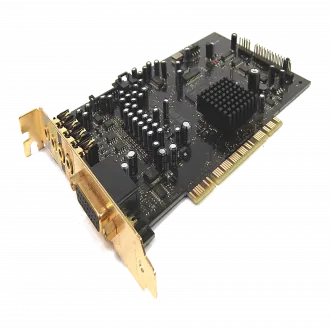The X-Fi (for "Extreme Fidelity") was released in August 2005 and was initially released in XtremeMusic, Platinum, Fatal1ty FPS, and Elite Pro configurations. Three additional models were added in October 2006; the X-Fi 'XtremeGamer', X-Fi 'Xtreme Audio' and the X-Fi 'XtremeGamer Fatal1ty Pro'. The 'XtremeGamer Fatal1ty Pro' is a mainstream gaming model which is identical to the high-end gaming Fatal1ty FPS but lacks the additional I/O box and remote control accessories; the 'XtremeGamer' is a model optimized for gaming which lacks the I/O extensibility of the higher end X-Fi models; the 'Xtreme Audio', despite the "X-Fi" label, is the only product in the X-Fi line not using the EMU20K1 chip (CA20K1) but an older chip similar to the Audigy SE and SB Live! cards (CA0106-WBTLF) and thus lacks the hardware acceleration of 3D sound and EAX sound effects, gaming and content creation features and the I/O extensibility of all the other X-Fi models. It is not marketed as supporting gaming or EAX. Creative also released an external solution (named x-mod) in November 2006 which is listed in the same category as the rest of the X-Fi lineup, but is only a stereo device, and lacks the specifications of the internal offerings.
The 130 nm EMU20K1 audio chip operates at 400 MHz and has 51 million transistors. The computational power of this processor, i.e. its performance, is estimated as 10,000 MIPS (million instructions per second), which is actually about 24 times higher than the estimated performance of its predecessor—the Audigy processor. It is interesting to note that the processor’s computational power is optimized for the work mode selected in the software. With the X-Fi's "Active Modal Architecture" (AMA), the user can choose one of three optimization modes (Gaming, Entertainment, and Creation), each of which enables a different combination of the features of the chipset. The Xtreme Audio model lacks the EMU20K1 chip and thus only supports the "Entertainment" mode via software emulation, while all other models support all three modes. X-Fi models that support "Gaming" mode use EAX 5.0, which supports up to 128 3D-positioned voices with up to four effects applied to each. The X-Fi, at its release, offered some of the most powerful mixing capabilities available, and made it a powerful entry-level card for home musicians.
The audio processor on X-Fi was by far the most powerful at its time of release, offering an extremely robust sample rate conversion (SRC) engine in addition to enhanced internal sound channel routing options and greater 3D audio enhancement capabilities. A significant portion of the audio processing unit was devoted to this resampling engine. The SRC engine was far more capable than previous Creative sound card offerings, a limitation that had been a major thorn in Creative's side. Most digital audio is sampled at 44.1 kHz, a standard no doubt related to CD Digital Audio, while sound cards were often designed to process audio at 48 kHz. So, the 44.1 kHz audio must be resampled to 48 kHz (Creative's previous cards' DSPs operated at 48 kHz) for the audio DSP to be able to process and affect it. A poor resampling implementation introduces artifacts into the audio which can be heard, and measured as higher intermodulation distortion, within higher frequencies (generally 16 kHz and up). X-Fi's resampling engine produces a near-lossless-quality result, far exceeding any known audio card DSP available at the time of release. This functionality is used not only for simple audio playback, but for several other features of the card such as the "Crystalizer".
The 20K1 chip is able to utilize a significant amount of RAM to store sound effects for faster and improved processing, just like the previous E-mu 10K-series and E-mu 8000. This feature, dubbed X-RAM by Creative and found on the higher-end models in the X-Fi line (the Elite Pro, Fatal1ty and XtremeGamer Fatal1ty Pro Series), is claimed to offer quality improvement through audio processing capability enhancement, in addition to further reduction in host system CPU overhead.
Download the .exe file below, then run on the machine you want to install the sound card on as an administrator.
All Model numbers for this device
Sound Blaster X-Fi XtremeGamer Fatal1ty® Professional Series
Sound Blaster X-Fi Platinum Fatal1ty Champion Series
Sound Blaster X-Fi XtremeMusic
Sound Blaster X-Fi XtremeGamer
Sound Blaster X-Fi Platinum
Sound Blaster X-Fi Fatal1ty
Sound Blaster X-Fi Elite Pro
Sound Blaster X-Fi Elite
Sound Blaster X-Fi
